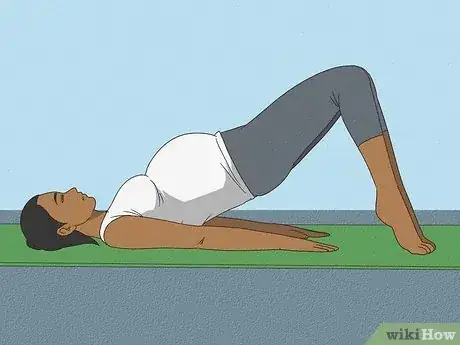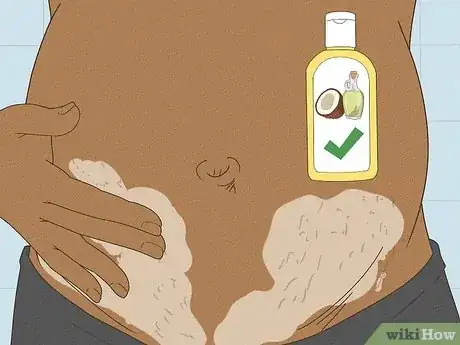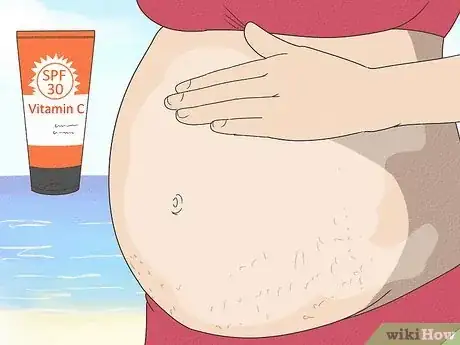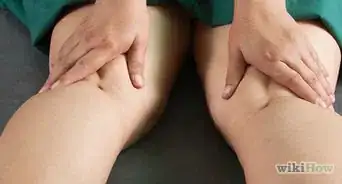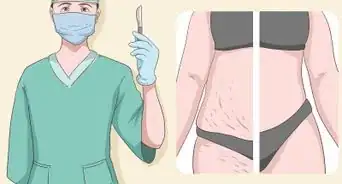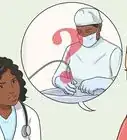This article was co-authored by Patricia Ladis PT, CBBA. Patricia Ladis PT, CBBA is a Licensed Physical Therapist and the Founder of WiseBody Physical Therapy out of New York, NY. With over 22 years of experience, Patricia specializes in providing a collaborative and holistic approach to pain, including nerve and chronic pain, injury prevention, and prenatal/postpartum wellness. She holds a BS in Physical Therapy from New York University. Patricia is a Certified Behavioral Breathing Analyst (CBBA) and holds certifications in Kinetic Control’s Performance Matrix Assessment Screen and the Integrative Systems Model. She co-founded First 1000 Days of Wellness, an educational platform for practitioners and the public to improve perinatal wellness. Patricia has been featured in Forbes, Vogue, and Men’s Health and has made television appearances on NBC and CBS.
wikiHow marks an article as reader-approved once it receives enough positive feedback. In this case, 100% of readers who voted found the article helpful, earning it our reader-approved status.
This article has been viewed 1,471,444 times.
Pregnancy stretch marks are a natural result of the skin around the abdomen stretching out to accommodate a growing belly. They start out as red streaks and turn silvery over time. It is possible to prevent and reduce the appearance of stretch marks if you act early in the pregnancy. Learn how to prevent stretch marks with lifestyle changes, a new skin care regimen, and practicing maintenance after the baby is born.
Steps
Make Lifestyle Changes to Prevent Stretch Marks
-
1Eat a skin-nourishing diet.[1] You're probably already eating healthy, balanced meals to make sure your baby is getting enough vitamins and nutrients. Incorporating foods that are especially beneficial for the health of your skin can improve your skin's elasticity, which helps prevent stretch marks from forming. Add the following foods to your daily diet:
- Foods rich in antioxidants, which help nourish and protect skin. Eat plenty of spinach, blueberries, strawberries, and other fresh fruits and vegetables.
- Foods containing vitamin E, which protects skin cell membranes. Eat nuts, seeds, avocados, broccoli, and collard greens.
- Foods containing vitamin A, which repairs skin tissues. Eat carrots, sweet potatoes, mango, squash, and red bell peppers.
- Foods containing omega 3s, which keep cell membranes healthy and make your skin glow. Eat fish, fish oil, walnuts, eggs and oysters. Make sure to thoroughly cook eggs and oysters. Don't eat fish high in mercury. Mercury consumed during pregnancy has been linked to developmental delays and brain damage.
-
2Stay hydrated. Water helps detoxify your body and keeps your skin cells plump, which makes your skin healthier and more likely to bounce back from the stress caused by stretching. Get plenty of water by practicing these habits:
- Drink 8 glasses of water a day. If you find it difficult to ingest this much water, carry a large water bottle that holds the equivalent of 2 glasses (16 ounces) of water. Refill it 4 times throughout the day, rather than having to refill a single glass 8 times. It will make drinking enough water less of a hassle.
- Drink herbal tea. Choosing teas without caffeine helps your body stay hydrated, and can alleviate the boredom of drinking only water every day.
- Eat watery fruits and vegetables. Eating vegetables that contain a lot of water is another great way to hydrate yourself. Eat big salads filled with cucumbers, fresh bell peppers, and celery. Choose watermelon, strawberries, honeydew, and other watery fruits instead of eating baked desserts.
Advertisement -
3Exercise during pregnancy.[2] Exercising helps the skin retain its elasticity by improving your body's circulation. As an added benefit, exercise will help prevent you from gaining too much weight, too quickly, nipping stretch marks in the bud. Incorporate exercise into your daily schedule in the following ways:
- Perform exercises meant to make pregnancy easier on your body.[3] Stretches, Kegel exercises, and other simple movements can help keep your blood moving and keep you more comfortable during pregnancy.[4]
- Try pregnancy yoga and other low-impact exercises. Yoga and Pilates give you an excellent workout without requiring you to move in ways that may feel uncomfortable while you're pregnant.[5]
-
4Gain weight gradually. Stretch marks happen when you gain a lot of weight, fast. If you follow your doctor's guidelines for gaining weight gradually, rather than putting on your pregnancy weight all at once, you greatly reduce the chance that you'll end up with stretch marks.
- Avoid "eating for two." You should be eating more calories that you did before you were pregnant, but not twice as many.[6]
- When you feel cravings coming on, have a little taste of the food you really want - say, ice cream - and a hefty serving of strawberries or fruit. You'll satisfy your palate and feel full.
Start a New Skin Care Regimen to Prevent Stretch Marks
-
1Practice dry brushing. Exfoliating your skin using a dry brush improves your circulation and keeps your skin healthy. Its recommended as a way to reduce the appearance of stretch marks that have already formed, but dry brushing can also be used as a preventative technique.
- Use a dry brush made from natural fibers. The bristles should be stiff, but not too tough.
- Start from the bottom of your legs and brush your skin upward toward your heart. Focus on areas where stretch marks might become a problem, like your buttocks and abdomen. When you're finished brushing, take a shower to wash away the dead skin cells.
- Don't use a dry brush on your breasts, since the skin there is more sensitive and could be damaged by brushing.
-
2Don't use harsh chemicals on your skin. Many commercial body washes contain sulfates, which can dry out your skin and reduce its elasticity over time. Choose a cleanser made with natural oils that will hydrate your skin, rather than making it lose too much moisture.
- Coconut oil can act as a healthy skin cleanser. Rub it over your skin, rinse with warm water, and pat your skin dry with a soft towel.
- It may not be necessary to use a cleanser on your skin, especially if it's prone to becoming dry. Wash your skin with lukewarm water and pat it dry.
-
3Moisturize your skin. Its important to use a moisturizer to hydrate the skin on your belly, sides, lower back, thighs, legs, and anywhere else you might get stretch marks. Regular lotion won't penetrate the skin deeply enough to keep it hydrated, so use a product specifically made for pregnant women, or choose a natural oil.
- Cocoa butter, kokum butter, almond oil, egg oil, shea butter, and wheatgerm oil are popular and effective choices for moisturizing skin during pregnancy. Pure lanolin, which is made from the oils produced by sheep to keep their wool supple, also works very well. Other popular oils include tamanu oil, rosehip oil and baobab oil. These oils are rich in anti-inflammatory and anti-oxidant properties. They support the regeneration of new tissues and accelerate the formation of healthy skin.
- Moisturize your skin in the morning after bathing and again at night. If you notice itching where your skin is being stretched, that is a sign to add more moisturizer in that area.
-
4Use sunscreen. If you go swimming or spend some time in the sun, make sure you use plenty of sunscreen on your belly, sides, chest and other areas where stretch marks might occur. The sun's rays are tough on skin, so its especially important to protect yourself during pregnancy.
Maintain a Good Routine After You Give Birth
-
1Continue eating foods that nourish your skin. Don't give up the fresh fruits and vegetables, nuts, fish, and avocados after your baby is born. The period after you give birth is an important window for making sure your skin continues to get the vitamins it needs to renew itself and recover from stretching.
- Don't go on a crash diet to lose weight after pregnancy. Lose it gradually, just as you gained it gradually, so your skin has time to tighten itself.
- Continue hydrating yourself with plenty of water to help your skin retain elasticity.
-
2Ramp up the exercise. Now that the baby has been born, you are no longer limited to exercises that are safe to do during pregnancy. Exercise four or five times a week, focusing in the following areas:
- Strength training. Building strong muscles helps your skin tighten up. Try weightlifting, and work with a trainer to figure out what exercises are right for you.
- Cardio workouts. Swimming, running, and biking keep your circulation healthy and help your skin bounce back into shape.
-
3Treat stretch marks. If you do end up with a few stretch marks - which can happen even if you take preventative measures - treat them while they're still new. Apply a stretch mark salve containing glycolic acid to your abdomen, sides, and wherever red streaks have appeared.
- Prescription creams containing retinoids, which should not be ingested while you are pregnant or nursing, have also been shown to help with stretch marks.[7]
- Using glycolic acid and retinoids at the same time may produce better results than using the products on their own.[8]
- If these products just aren't making the marks go away, laser treatments for stretch mark removal are an effective choice.[9]
Expert Q&A
-
QuestionWhy am I gaining weight so fast during pregnancy?
 Patricia Ladis PT, CBBAPatricia Ladis PT, CBBA is a Licensed Physical Therapist and the Founder of WiseBody Physical Therapy out of New York, NY. With over 22 years of experience, Patricia specializes in providing a collaborative and holistic approach to pain, including nerve and chronic pain, injury prevention, and prenatal/postpartum wellness. She holds a BS in Physical Therapy from New York University. Patricia is a Certified Behavioral Breathing Analyst (CBBA) and holds certifications in Kinetic Control’s Performance Matrix Assessment Screen and the Integrative Systems Model. She co-founded First 1000 Days of Wellness, an educational platform for practitioners and the public to improve perinatal wellness. Patricia has been featured in Forbes, Vogue, and Men’s Health and has made television appearances on NBC and CBS.
Patricia Ladis PT, CBBAPatricia Ladis PT, CBBA is a Licensed Physical Therapist and the Founder of WiseBody Physical Therapy out of New York, NY. With over 22 years of experience, Patricia specializes in providing a collaborative and holistic approach to pain, including nerve and chronic pain, injury prevention, and prenatal/postpartum wellness. She holds a BS in Physical Therapy from New York University. Patricia is a Certified Behavioral Breathing Analyst (CBBA) and holds certifications in Kinetic Control’s Performance Matrix Assessment Screen and the Integrative Systems Model. She co-founded First 1000 Days of Wellness, an educational platform for practitioners and the public to improve perinatal wellness. Patricia has been featured in Forbes, Vogue, and Men’s Health and has made television appearances on NBC and CBS.
Licensed Physical Therapist Different hormonal shifts can happen during your pregnancy that can increase your weight. If you're gaining too much weight in a short period of time, talk to your doctor, but know that it's possible that you were underweight or that a surge of hormones is the culprit.
Different hormonal shifts can happen during your pregnancy that can increase your weight. If you're gaining too much weight in a short period of time, talk to your doctor, but know that it's possible that you were underweight or that a surge of hormones is the culprit. -
QuestionWhat kinds of exercises are safe during pregnancy?
 Patricia Ladis PT, CBBAPatricia Ladis PT, CBBA is a Licensed Physical Therapist and the Founder of WiseBody Physical Therapy out of New York, NY. With over 22 years of experience, Patricia specializes in providing a collaborative and holistic approach to pain, including nerve and chronic pain, injury prevention, and prenatal/postpartum wellness. She holds a BS in Physical Therapy from New York University. Patricia is a Certified Behavioral Breathing Analyst (CBBA) and holds certifications in Kinetic Control’s Performance Matrix Assessment Screen and the Integrative Systems Model. She co-founded First 1000 Days of Wellness, an educational platform for practitioners and the public to improve perinatal wellness. Patricia has been featured in Forbes, Vogue, and Men’s Health and has made television appearances on NBC and CBS.
Patricia Ladis PT, CBBAPatricia Ladis PT, CBBA is a Licensed Physical Therapist and the Founder of WiseBody Physical Therapy out of New York, NY. With over 22 years of experience, Patricia specializes in providing a collaborative and holistic approach to pain, including nerve and chronic pain, injury prevention, and prenatal/postpartum wellness. She holds a BS in Physical Therapy from New York University. Patricia is a Certified Behavioral Breathing Analyst (CBBA) and holds certifications in Kinetic Control’s Performance Matrix Assessment Screen and the Integrative Systems Model. She co-founded First 1000 Days of Wellness, an educational platform for practitioners and the public to improve perinatal wellness. Patricia has been featured in Forbes, Vogue, and Men’s Health and has made television appearances on NBC and CBS.
Licensed Physical Therapist There's all sorts of exercises for pregnant women! My favorite option is to dance, since it gets you moving around. When you actually enjoy an exercise, you'll get more health benefits. Yoga and pilates are also great options.
There's all sorts of exercises for pregnant women! My favorite option is to dance, since it gets you moving around. When you actually enjoy an exercise, you'll get more health benefits. Yoga and pilates are also great options.
Warnings
- Make sure the stretch mark products you use while pregnant or nursing do not warn, "not for use by pregnant or nursing women."⧼thumbs_response⧽
References
- ↑ Patricia Ladis PT, CBBA. Licensed Physical Therapist. Expert Interview. 19 March 2021.
- ↑ Patricia Ladis PT, CBBA. Licensed Physical Therapist. Expert Interview. 19 March 2021.
- ↑ Patricia Ladis PT, CBBA. Licensed Physical Therapist. Expert Interview. 19 March 2021.
- ↑ http://www.webmd.com/baby/pregnancy-safe-exercises
- ↑ Patricia Ladis PT, CBBA. Licensed Physical Therapist. Expert Interview. 19 March 2021.
- ↑ http://www.webmd.com/baby/features/pregnant-eat-for-two-right
- ↑ http://www.webmd.com/baby/features/stretch-marks-getting-under-your-skin?page=2
- ↑ http://www.webmd.com/baby/features/stretch-marks-getting-under-your-skin?page=2
- ↑ http://www.webmd.com/baby/features/stretch-marks-getting-under-your-skin?page=2
About This Article
To prevent stretch marks during pregnancy, eat foods that increase your skin’s elasticity. Focus on consuming foods that are rich in antioxidants, such as blueberries and spinach. Also munch on seeds, nuts, avocados, and mangoes to get vitamins E and A. Finally, make sure to fill up on omega 3s from walnuts and eggs. After pregnancy, reduce stretch marks by applying creams with glycolic acid. To learn more, such as how to exercise and keep your skin healthy, keep reading the article!



